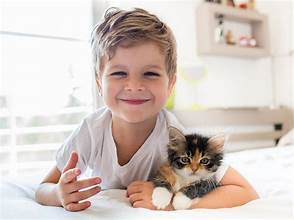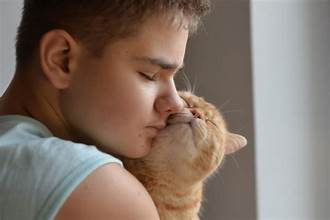A Gentle Pawprint on the Heart
For children with special needs, the world can sometimes feel overwhelming, unpredictable, and emotionally exhausting. But for many families, one quiet, comforting solution often comes with a purr and a gentle nudge—a cat. Whether through soft cuddles, steady companionship, or the gentle sound of purring, cats provide powerful emotional relief to children experiencing anxiety.

The Calming Power of Cats
Cats are naturally attuned to calm, quiet environments. Their body language is subtle, their voices are soft, and their rhythms are gentle, making them ideal companions for children who are easily overstimulated or anxious.
Top Ways Cats Soothe Anxiety in Children with Special Needs
1. Purring Promotes Peace
Cats’ purring is more than adorable—it’s healing. Research has shown that the frequency of a cat’s purr (between 20–140 Hz) may promote healing and relaxation. Children with anxiety often find the rhythmic purr of a cat incredibly soothing, especially when sitting quietly or falling asleep.
2. Grounding Through Touch
When a child pets a cat, the repetitive motion and soft texture engage their senses in a calming way. This tactile grounding helps children regulate strong emotions and feel more present, easing anxiety or sensory overload episodes.
3. Non-Judgmental Companionship
Cats don’t require conversation, eye contact, or explanation. Their unconditional presence is comforting and healing for children who struggle with verbal expression or social pressure. A cat simply shows up with warmth, softness, and steady companionship.
4. Creating Predictable Routines
Cats thrive on routine—feeding time, playtime, and naps. Involving a child in daily cat care can create a predictable rhythm that supports structure and emotional balance. This predictability can ease anxiety by reducing uncertainty and helping the child know what to expect.
Who Benefits the Most?
Cats can be beneficial for children living with:
- Autism Spectrum Disorder (ASD)
- Sensory Processing Disorder
- Social Anxiety
- Generalized Anxiety Disorder (GAD)
- ADHD

While every child is different, many parents and therapists report that their children feel calmer, more focused, and more secure when a feline companion is nearby.
Real Stories: Magic in Everyday Moments
Families have shared heartwarming moments of “meow magic”:
“Our son doesn’t speak much, but his cat, Luna, always knows when he’s overwhelmed. She’ll curl up on his lap, and he’ll start stroking her fur without being asked. It’s the only time he truly looks relaxed.” — Emily, parent of a 7-year-old with ASD.
“My daughter used to panic at night. Now her cat sleeps at the foot of her bed, and it’s the first time she’s stayed in her room all night long.” — Marcus, father of a child with anxiety disorder.
Tips for Introducing a Cat to a Child with Special Needs
- Choosing the Right Cat: A Key Step in the Journey
Look for calm, gentle breeds like Ragdolls and British Shorthairs or affectionate shelter cats with mellow personalities.
- Set Boundaries Early:
Teach the child to interact gently and respect the cat’s signals.
- Create Safe Zones:
The cat and the child should have calm, quiet spaces to retreat to when needed.
- Let Bonding Happen Naturally:
Don’t force interaction. Let the relationship grow with time, trust, and mutual respect.
Best Cat Breeds for Emotional Support
While personality matters more than breed, these cats are often recommended for their calm, affectionate nature:
- Ragdoll
- Birman
- Scottish Fold
- American Shorthair
- Russian Blue
Many mixed-breed shelter cats also make incredible emotional support companions—always consider rescue first!
Final Thoughts: When Magic Feels Like Meow
The bond between a child with special needs and a cat isn’t just cute—it’s a unique and deeply therapeutic connection. From silent understanding to quiet companionship, cats provide emotional shelter in a loud and confusing world. With their soft presence and unwavering loyalty, these feline friends work magic in the lives of children who need comfort most.




